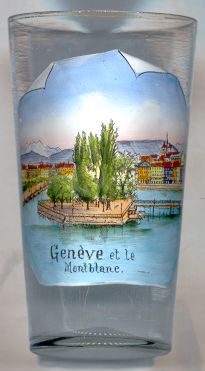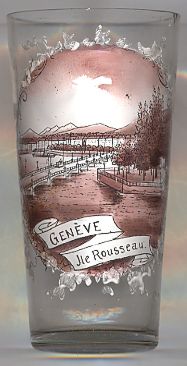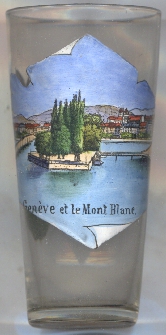

|
| SCHWEIZ / SUISSE / SVIZZERA / SVIZRA | SWITZERLAND |
| Genf / Genève / Ginevra / Genevra |
• fr: Genève
| • rm: Genevra
| • de: Genf
| • it: Ginevra
| |
• tr: Cenevre
Genève is situated at an elevation of 424 m on the banks of the southern tip of Lake Geneva in Southwest Switzerland. Archaeological finds show that the area has been inhabited for at least 12,000 years. Geneva became part of the Roman empire in 121 BC, an episcopal seat in the 4th century, was conquered by Burgundy in the 5th century, and eventually cyme under Frankish rule. During the 1st half of the 11h century, Geneva became a border post of the Holy Roman Empire. It was ruled by prince-bishops with the counts of Geneva as feudal vassals. Since the early 14th century, there were continuous struggles between the citizens, the counts and bishops of Geneva, and the counts of Savoy. In 1536, Geneva introduced the Reformation and declared itself an independent republic. The catholic bishops moved their seat to Annecy in 1535. Johannes Calvinus (real name Jean Cauvin) was invited to take up residence in the city and made Geneva a centre of the Protestant faith; Geneva even was nicknamed the 'Calvinist Rome'. During the 17th century, Geneva became a centre of banking, watchmaking and enamel, as well as a centre of science and printing. Among the most prominent residents of that time were Voltaire and the native Genevan Jean Jacques Rousseau. In 1798, Geneva was annexed by France. After the Napoleonic wars, Geneva was admitted to the Swiss Conferedation in 1815. The Genevan Henri Dunant founded the International Committeee of the Red Cross here in 1864, for which he was awarded the Nobel Prize in 1901. Geneva's international vocation was confirmed after World War I in 1920 when it became the seat of the League of Nations, the predecessor of the United Nations and many other international organisations.
On the 10th of September 1898 Empress Elisabeth of Austria was assassinated on the sea-side promenade by the Italian anarchist Luigi Luccheni. Luccheni had come to Geneva with the intention to murder a well-known person. He originally planned to kill Louis Philippe, the Duke of Orléans, but this was prevented by the early departure of the duke. When it was discovered that Elisabeth had come to Geneva on one of her many travels, Luccheni decided to take her as a victim.



In 2000 the city of Genève was awarded the Wakker Prize of the Swiss Heritage Society for the development and
preservation of its architectural heritage.
Other cities that have been awarded this prize and which are depicted on glasses of this collection are:
Altdorf (2007),
Baden (2020),
Basel (1996),
Bern (1997),
Biel/Bienne (2004),
La Chaux-de-Fonds (2011),
Lausanne West (Bussigny-près-Lausanne, Chavannes-près-Renens, Crissier, Ecublens, Lausanne, Prilly, Renens, Saint-Sulpice, Villars-Sainte-Croix) (2011),
Montreux (1990),
Sankt Gallen (1992),
Solothurn (1980),
Stein am Rhein (1972),
Wil (1984),
Winterthur (1989).
The pictures on all three glasses show the  river
river Montblanc,
Montblanc,
 Île Rousseau [centre] is a tiny island located in the middle of the river Rhône,
where the river flows out of Lake Geneva.
The island is home to many birds that live in pens. Originally the island had been known as Île aux Barques and was renamed
in honour of Jean-Jacques Rousseau in 1834. A walkway connects the island with the Pont des Bergues.
A statue of Rousseau, created by the sculptor James Pradier, was unveiled in 1835.
Île Rousseau [centre] is a tiny island located in the middle of the river Rhône,
where the river flows out of Lake Geneva.
The island is home to many birds that live in pens. Originally the island had been known as Île aux Barques and was renamed
in honour of Jean-Jacques Rousseau in 1834. A walkway connects the island with the Pont des Bergues.
A statue of Rousseau, created by the sculptor James Pradier, was unveiled in 1835.
The  Pont du Mont Blanc [left], a steel bridge,
was originally built in 1862. In the early 1900s, traffic had become too heavy for the old bridge, so that it was rebuilt in iron and concrete masonry
in 1903. In 1965–1969 the bridge was rebuilt and widened again.
Pont du Mont Blanc [left], a steel bridge,
was originally built in 1862. In the early 1900s, traffic had become too heavy for the old bridge, so that it was rebuilt in iron and concrete masonry
in 1903. In 1965–1969 the bridge was rebuilt and widened again.
![[scale]](lineal.jpg)